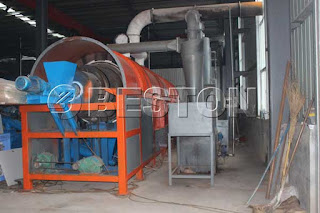Producing Biochar From Biomass Waste By a Charcoal Machine
Biochar is simply understood to be charcoal typically utilized for many agricultural purposes. The product is generated using a form of carbonization method that heat biomass within an environment with low oxygen. Once this carbonization reaction begins, it might be self-sustainable meaning it does not require any energy input externally. The by-products of the processes include very small quantities of CH4 (methane), H2 +CO (syngas), organic acids, tars as well as excess heat. Using a biochar production equipment, you can just complete the above-said process.
Once this device has become produced the biochar is spread over agricultural fields and mixed into the very top soil layer. This biochar has a number of agricultural benefits. Some of these include improving the crop yields, in some instances significantly if the soil is at an inadequate condition. It assists in avoiding fertilizer leeching and runoff that allows for the application of significantly less fertilizers along with decreasing agricultural pollution to surrounding environments. Additionally, it assists the soil to retain moisture, which assists the plants during drought periods.
One of many benefits of making biochar from biomass waste is that it replenishes marginal or exhausted soils with an organic carbon that encourages the increase of microbes in the soil that are essential for absorption of nutrients. Research has suggested that carbon found in biochar is able to stay stable for up to a millennia. That provides a sustainable and uncomplicated approach to sequester the carbon emissions that happen to be technologically feasible in developing and developed countries alike. The excess heat and syngas may also be used within a direct way or employed in producing numerous biofuels.
When making biochar from biomass waste has been created around 50% of carbon which plants absorb by means of CO2 out of your atmosphere is already “fixed” into this charcoal. The carbon present in this charcoal is mainly inert which implies they show a lack in reactivity biologically and chemically meaning they can be extremely resistant when it comes to decomposition. Scientists have found charcoal particles that are greater than 400 million yrs old within the sediment layers after wildfires occurred when the initial plant life began.
Of your various inorganic and organic substances that incorporate these carbon atoms, only the diamonds could very well provide a carbon store which is more permanent than charcoal. Therefore, biocharcoal provides us with among the best opportunities to eliminate the excessive amount of CO2 out of the atmosphere while sequestering it in a pretty much permanent in addition to environmentally important way.
Once this device has become produced the biochar is spread over agricultural fields and mixed into the very top soil layer. This biochar has a number of agricultural benefits. Some of these include improving the crop yields, in some instances significantly if the soil is at an inadequate condition. It assists in avoiding fertilizer leeching and runoff that allows for the application of significantly less fertilizers along with decreasing agricultural pollution to surrounding environments. Additionally, it assists the soil to retain moisture, which assists the plants during drought periods.
One of many benefits of making biochar from biomass waste is that it replenishes marginal or exhausted soils with an organic carbon that encourages the increase of microbes in the soil that are essential for absorption of nutrients. Research has suggested that carbon found in biochar is able to stay stable for up to a millennia. That provides a sustainable and uncomplicated approach to sequester the carbon emissions that happen to be technologically feasible in developing and developed countries alike. The excess heat and syngas may also be used within a direct way or employed in producing numerous biofuels.
When making biochar from biomass waste has been created around 50% of carbon which plants absorb by means of CO2 out of your atmosphere is already “fixed” into this charcoal. The carbon present in this charcoal is mainly inert which implies they show a lack in reactivity biologically and chemically meaning they can be extremely resistant when it comes to decomposition. Scientists have found charcoal particles that are greater than 400 million yrs old within the sediment layers after wildfires occurred when the initial plant life began.
Of your various inorganic and organic substances that incorporate these carbon atoms, only the diamonds could very well provide a carbon store which is more permanent than charcoal. Therefore, biocharcoal provides us with among the best opportunities to eliminate the excessive amount of CO2 out of the atmosphere while sequestering it in a pretty much permanent in addition to environmentally important way.





评论
发表评论